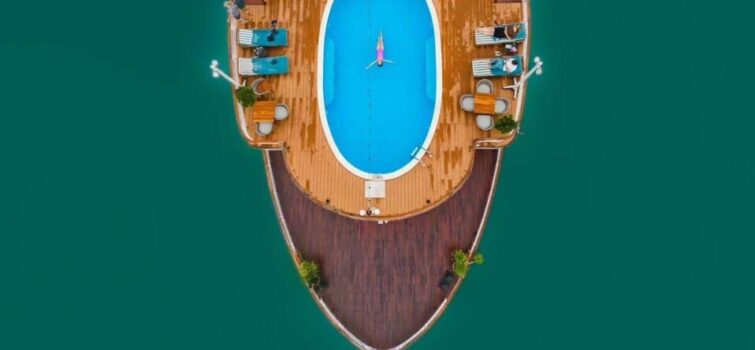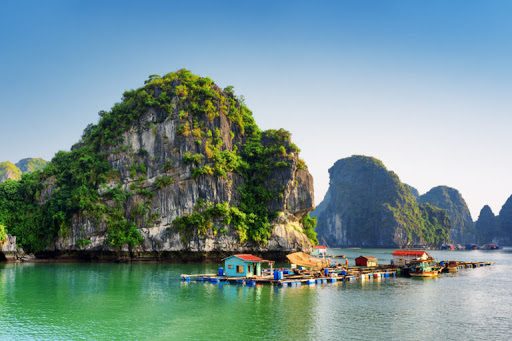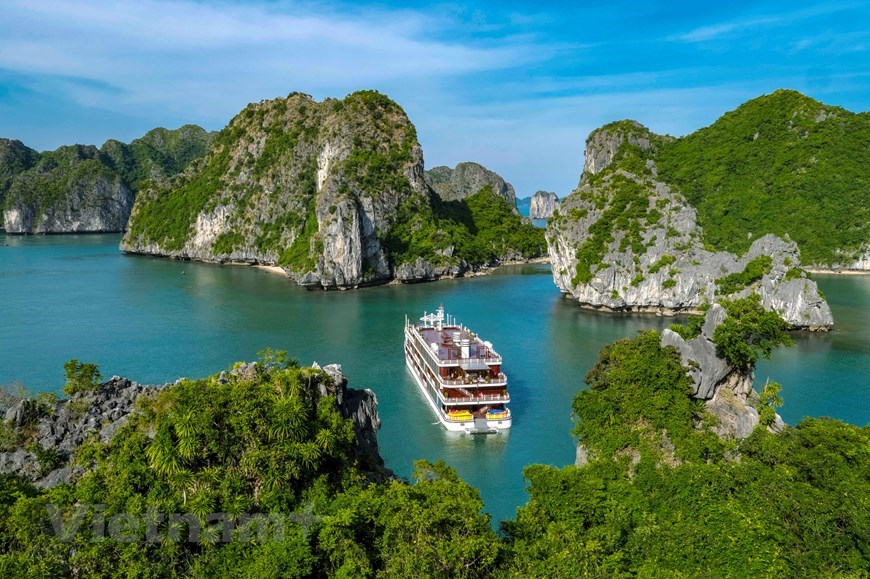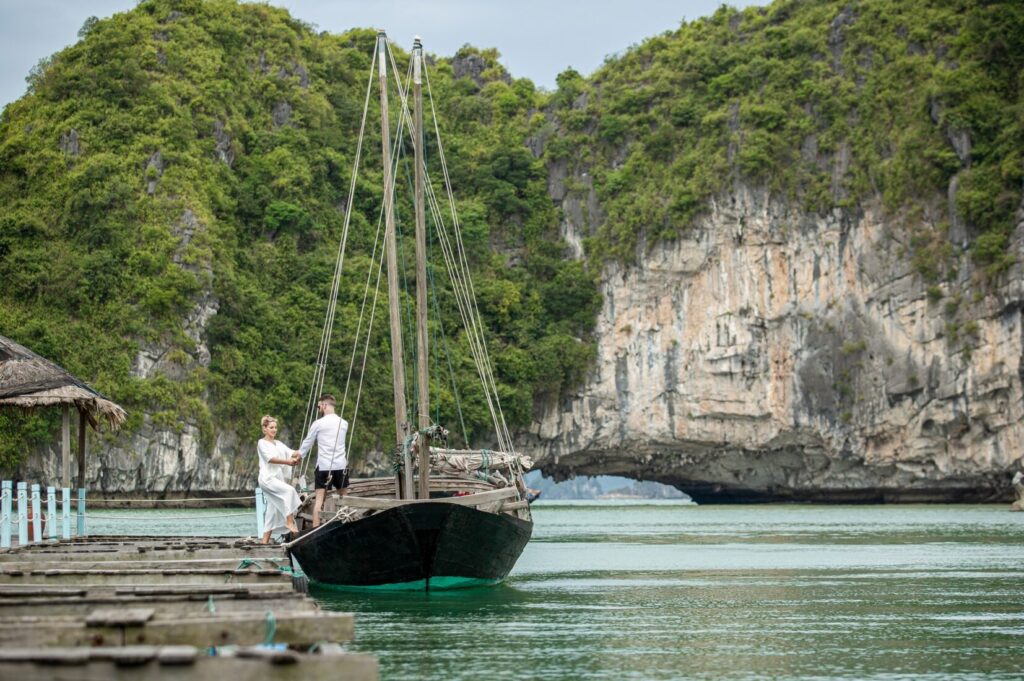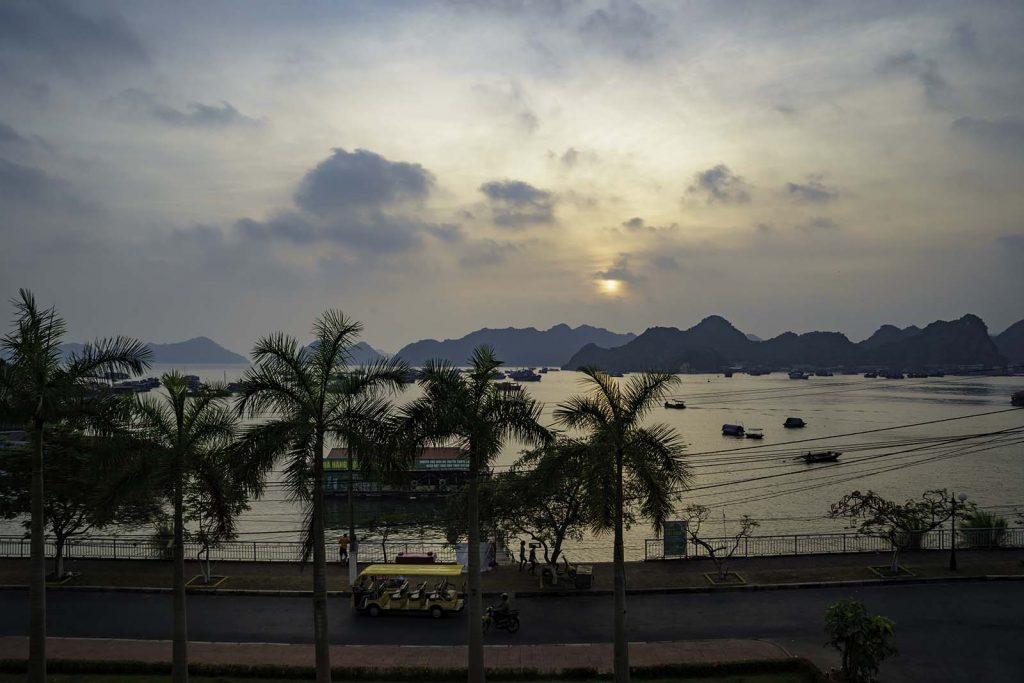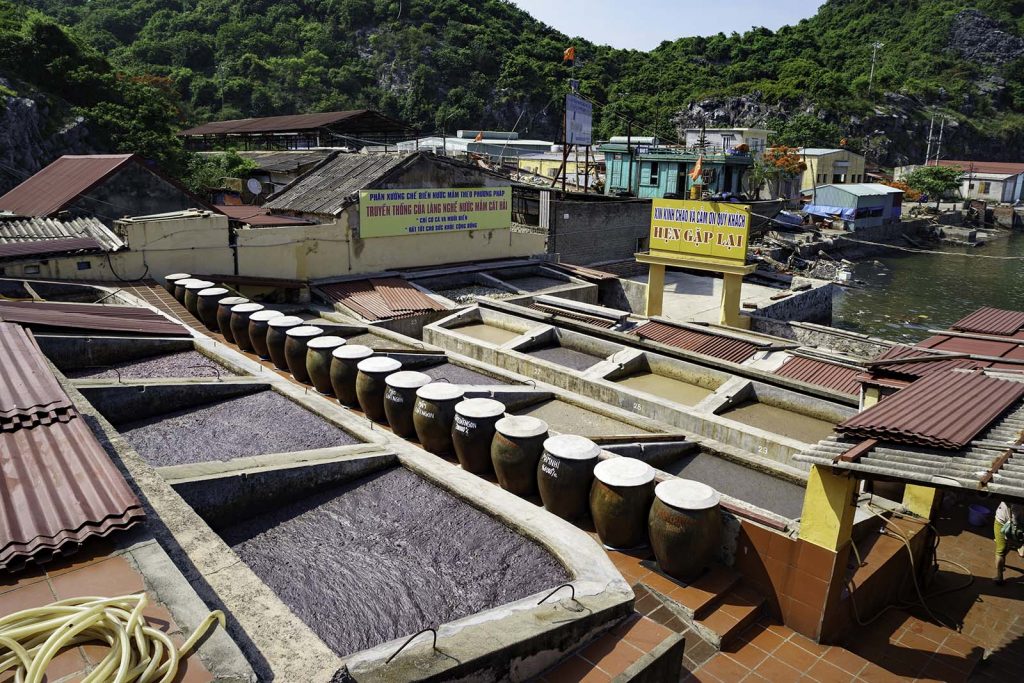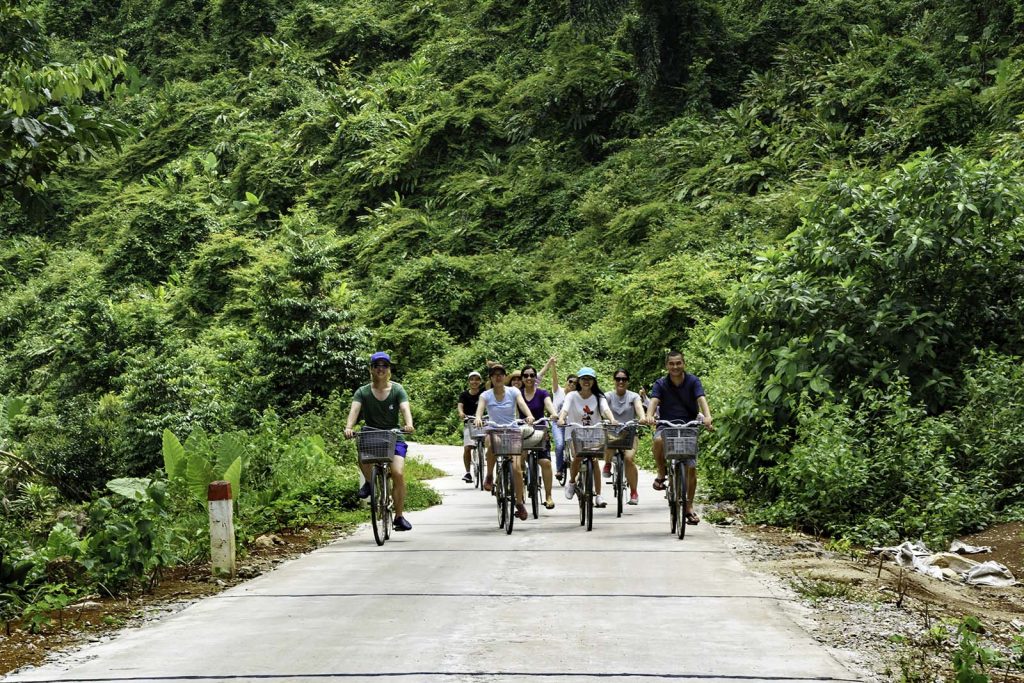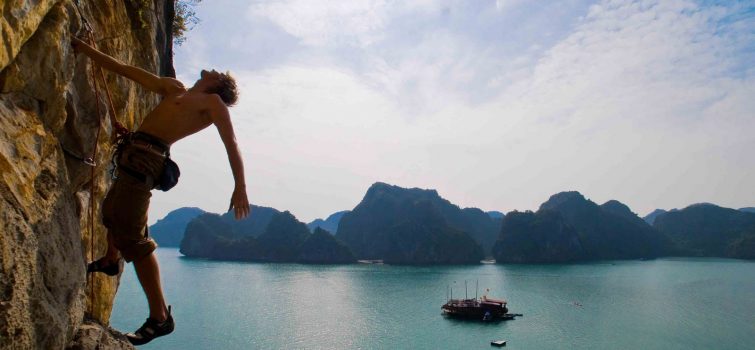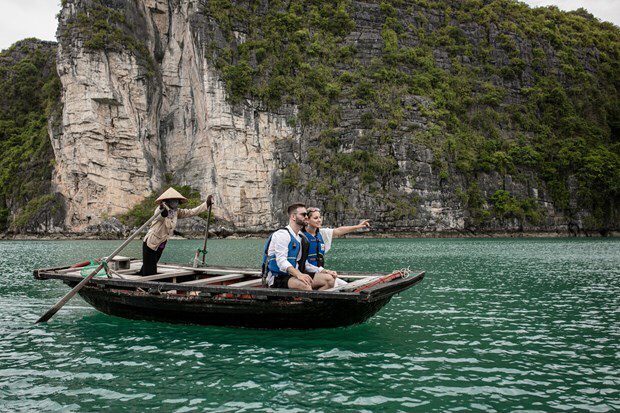Lux Group Sets Sail on the Blue Ocean Strategy.
Mr. Pham Ha, Founder and CEO of Lux Group, tells local media of his journey in the travel business and the current state of Vietnam’s tourism sector and his ambition to sail along the Vietnamese coastline.
From just one person in 2004, Luxury Travel and now Lux Group’s founder Pham Ha, with many years’ experience in the tourism industry, one laptop and one company, and a passion to provide unique travel experiences to luxury travellers to Vietnam and Southeast Asia. His passion is to elevate and raise the bar of the luxury side of Vietnam tourism.
The Lux Group (www.luxgroup.vn) now has a range of brands with 250 staff, rep offices on five continents, and investments in a variety of businesses such as luxury cruises, transportation, real estate, restaurants, hotels and resorts, and art auctions in Vietnam and Asia.
The entrepreneur, Pham Ha, and the Lux Group have won numerous prestigious travel awards including the Oscar of tourism industry: World Travel Awards 2022.
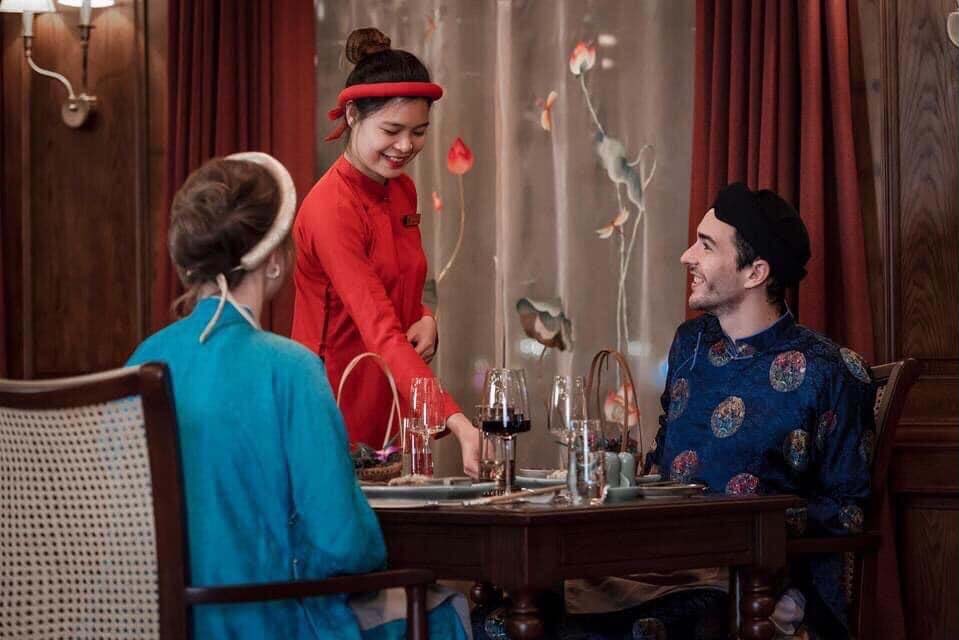
1.What brought you to the travel industry and why did you choose to serve luxury travelers instead of regular travelers?
My life is a journey, and happiness for me is the voyage, not the destination. I studied both English and French and I enjoy traveling, which brought me to this field. I was at university when I started out as a tour guide, then went through many positions in the travel industry before founding Luxury Travel in 2004 after having earned an BBA, focusing on the luxury segment, which remained unnoticed at that time. I chose the smaller way to achieve greater things, created appropriate experiences to meet customers’ travel wishes and demands, and gradually became a specialist in the domain of luxury travel. Travel is now all about destinations, experiences and memories.
2. How do you define luxury travel and the luxury that you bring to customers?
Vietnam tops lists for culture, food, outdoor travel, art and, of course, beaches and islands. We used the seven letters of the country’s name: V – Varied landscape, I – Indigenous culture, E – Exotic beaches, T – Timeless charm, N – heritage sites, A – Ancient cities, M – Memories to cherish forever.
There is no general definition of “luxury” for everyone. For people who travel abroad for the first time, this is a luxury for them, but for those who have traveled to more than 70 countries, like me, luxury travel is new experiences with personalized touches, where even the smallest needs are fulfilled. We define luxury as the whole of personalized experiences. We provide the right experience to our customers and touch their emotions with pleasant surprises.
#TouchingHearts with a team of locals and expatriates aims to give travelers exactly what they want and anticipate. With dedication and close association with agents and tour operators, we ensure the delivery of authentic luxury travel experiences using expertise, know-how, and solid infrastructure to our luxury clients. Our ambition is to help spread its values, mission, and vision.
3. Who are the luxury travelers coming to Vietnam? Do they have any special demands?
The luxury world includes luxury homes, personal luxury, and luxury services, and luxury travel is part of luxury services, providing high-class facilities with perfect services. Only 3 to 5 per cent of visitors to Vietnam are luxury travelers.
Unlike mass-market travelers, high-end travelers often prefer to travel in small groups and their requirements include privacy and authentic and unique experiences at destinations. This segment can be divided into five groups: The traditional group desires unique and different experiences to show off and attract the attention of others.
The second group enjoys luxury whenever they can. The third group seeks new experiences as they have money, and their numbers are increasing. The last two segments are honeymooners and groups of older people who like luxury as they love traveling with family.
Travel now is all about destinations, experiences and memories. Each destination has secrets, stories, and treasures of cuisine, nature, culture, art, heritage, history and people of that land, which is the main attraction for savvy travelers who come to explore, dream, discover, enjoy, relax, and immerse in cultural and natural heritage.
We are luxury minded experts with many years of experience and know-how expertise in creating unique and memorable travel experiences and creating memories to last a lifetime. Luxury is experiential and personal. We will exceed travelers’ expectations and promise them smooth travel with our award-winning service from our hearts to theirs.
As a long-standing player in the tourism industry, what do you think is negatively affecting the development of tourism?
I find Vietnam’s tourism sector lacks a long-term strategic vision, and development is scattered and unsustainable. In my opinion, there are four major issues that Vietnam needs to act upon immediately. The first is the formulation of tourism policies, the second is human resources, the third is tourism products, and the fourth is effective tourism promotion.
4. The Politburo has issued a resolution on tourism development for the first time and the government is also implementing solutions to develop tourism into a spearhead economic sector. What solutions would you prioritize to promote rapid and sustainable tourism development?
Should must review after 5 years, it’s important to move quickly from resolutions to specific government action, from the central to local levels. Most important is to change the perception of tourism at all levels. Officials must be aware that tourism earns revenue and creates jobs. I have proposed a tourism ministry at many tourism conferences, which would operate independently from the central to local level, following the Thai model. Of the four issues I mentioned above, priority should be given to creating more tourism products, providing incentives for businesses to do what the law does not grant.
We saw that inland waterways were too rudimentary to develop Red River tourism in the north. Hanoi’s ports are inferior to those in Ho Chi Minh City and Da Nang. Connecting Ha Long, Hai Phong, Ninh Binh and Nam Dinh, the great Red River was once the “King of Waterways”, according to the patriotic entrepreneur Bach Thai Buoi, who transformed transportation on the waterways of the north of Vietnam as a whole in the early 20th century. The poor development of Red River tourism is a major setback for Hanoi’s tourism. We bring heritage alive and conquer all rivers in the North by cruising expeditions.
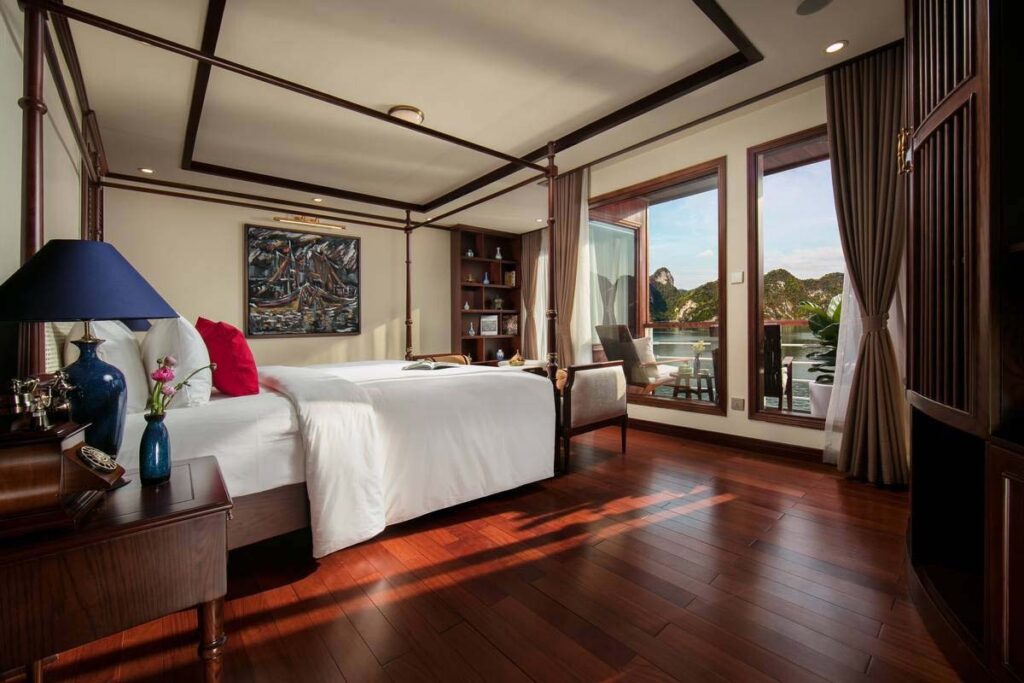
5. Hotel and resort investment is currently booming. Is this a good sign or a bad sign?
Vietnam’s tourism sector lacks forecasts and vision, and this type of sudden development is not sustainable. Many places with large-scale construction are actually ruining the landscape and tourism resources, such as Sapa, Ba Na, Nha Trang, and Phu Quoc Island. We never have any foreign tourists booking cable car tours. They go to Sapa, but not to take the cable car. Nha Trang has welcomed Chinese and Russian guests in massive numbers, so hotels mushroomed.
With a lack of a proper architectural planning, this affects the natural landscape and it also deters other Europeans from coming to Nha Trang. Now, it is completely dependent on Chinese travelers, but this will lead to an oversupply of hotels for Chinese mass tourists.
Encouraging European guests back to Nha Trang is difficult. Phu Quoc Island, meanwhile, is growing too quickly and this is also not good. Ha Long Bay is getting more and more crowded and polluted and local authorities do not create new experiences, instead banning popular activities such as swimming and visiting caves and new overnight cruises. Vietnam’s tourism sector should focus on the quality of incoming visitors and the quality of destinations. I am more sad than happy.
6. It seems you love the style of Emperor Bao Dai, as Emperor Cruises is based on his style. Is this style attractive for tourists? Do you find that foreign tourists are interested in this cultural nostalgia?
The Emperor Cruises Nha Trang, Halong and. Phu Quoc was inspired by the lavish lifestyle of Emperor Bao Dai, Vietnam’s last monarch. Built in the style of the 1930s, each suite features interesting stories from his life. There are eight ensuite cabins with a private balcony, ocean views, a butler service, and a limousine.
Cruising artfully, Emperor Cruises aims to bring a truly all-inclusive cruising experience, where you can enjoy every single moment on board and be treated like kings and queens with exquisite cuisine, 24-hour room service, and an interesting itinerary featuring many fun activities. Moreover, you can choose to dine whenever and wherever you wish. There are unlimited free massage and sauna services, food and beverages, and no bill to pay at the end.
I studied Vietnamese history and adore this important historical figure, who tried new ways to improve the country but at the wrong time. Incorporating culture and history into travel experiences is part of our plans and visitors love this nostalgia. Many travelers are familiar with the history of Vietnam but not so many people know about the emperor.
I was also fortunate enough to meet Mr. Nguyen Dac Xuan, a Hue historical researcher, and gathered a lot of unknown information and rare artifacts concerning Emperor Bao Dai, Queen Nam Phuong, and other members of the royal family. We would like visitors to experience the essence of Vietnam through authenticity, culture, heritage, history, and people while cruising with us amid the natural wonders of the country.
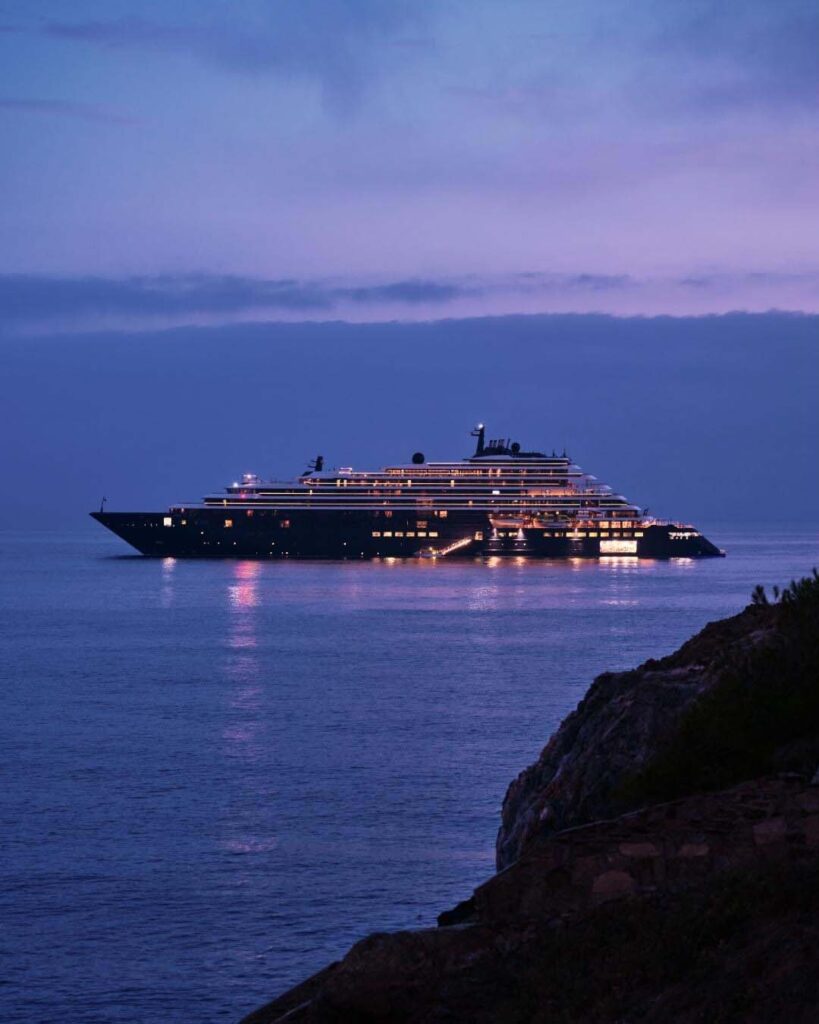
7. The last question, how about your sailing plam along the coastline of Vietnam and how about the recovery of your Lux Group in 2023?
We enjoyed 65% recovery last year and 75-90% to pre-pandemic levels. Some markets such as German market, 100% back to 2019 levels. We expect and prepare a full recovery next year. We go to ITB Berlin to promote our authentic, unique travel experiences and call for investors for our very potential of cruises and yachts in Vietnam.
The marine tourism sector, which is a top priority of the country’s sea economy Master Plan 2030-45, has been struggling to attract investment in cruise harbours and coastal infrastructure to lure globally branded cruise fleets connected with worldwide destinations. Cruise services are one of the key products in building marine tourism as a core part of the ‘blue sea economy’ plan.
The coast of Vietnam is ranked the 33rd in the world. This nation ranks in the top 12 countries for the most beautiful bays in the world including Halong, Lan Ha, Lang Co and Nha Trang. Although Vietnam has 3,260 km of coastline, 125 world- class beautiful beaches, 3000 islands, and 28 coastal cities, it still does not have a cruise ship fleet. Vietnam must have cruise ships along the coast and to carry passengers from Vietnam to other countries.
Making a 67.3 per cent share of the country’s total tourism revenue, a top favourite ocean destination among 156 beach nations, cruise tourism in Vietnam has not been promoted properly so far. The number of cruise tourists accounts for only 2-3% of the total number of international visitors to Vietnam. It’s necessary to attract investors to invest in cruise ships and yachts with Vietnamese nationality that run along the coast. Be the first to cruise along Vietnamese coast in 2025 aboard our Lux Cruises!
Discover, Explore, Experience Lan Ha Bay, One of the Most Beautiful Bays in the World.
Dark and bright cave
Overview
Dark and Bright Cave lie in the bordering area between Lan Ha Bay and Halong Bay, this area is located in the protected area of Cat Ba Biosphere Reserve. Coming to Dark and Bright Cave, tourists will be indulged in nature with the blue water and fresh air. The best way to admire the majestic foundation of the cave is to go kayaking or row bamboo boats. Inside Dark and Bright Cave, there are a lot of emulsions and stalactites with different shapes. This is also a safe place for cruises to anchor and provide shelter for fishermen in the rainy season. Adventuring along Dark and Bright Cave, visitors will be overwhelmed by the poetic, lyrical and pristine beauty that Mother Nature has endowed this destination.
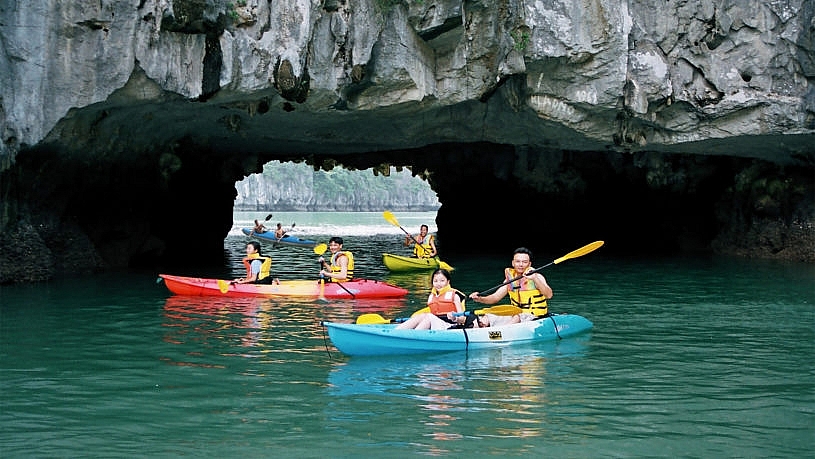
About Dark and Bright Cave Halong Bay
Dark Cave and Bright Cave are underwater ones, so the formation of these caves is different from other dry caves. Thus, Dark Cave and Bright Cave possess outstanding and distinguishing beauty. In the process of geological activities in Halong Bay, there are three types of caves which were formed by the impact of water on the karst topography. They are the ancient underground cave, Carxto cave, and frog’s jaw cave. Dark Cave and Bright Cave are frog’s jaw caves, while the cave floor is under the sea, the cave ceiling is beyond the water. With the unique topography and tectonics, the caves are only accessible by boat.
Things to do in Dark and Bright Cave Halong Bay
Tourists coming to Dark and Bright Cave have plentiful interesting options. You can choose to participate in many water activities such as: go kayaking to explore the beauty of the magnificent scenery, sit and sunbathe on the beach or swim and snorkel to discover the marine life.
Dark and Bright Cave is an ideal destination for those who are keen on kayaking and exploring nature. Kayaking is the best way to explore Dark and Bright Cave. With the kayak, visitors can get closer to the foot of the mountain, discover the beauty of nature, clearly see the erosion of water and waves into the limestone cliffs. When rowing into the caves, you are sure to be overwhelmed by the miraculous stalactites on the ceiling and cave walls. This is also a rare chance for you to capture memorable beautiful photos of the majestic Halong Bay.
Go through Bright cave, tourists will come to a lovely valley surrounded by spectacular mountain ranges. This setting gives travellers a feeling of being lost in Heaven. It is such a wonderful experience to sit on the kayak and slowly watch the scenery, breath in the fresh air and feel the harmony among the sea, mountain and sky. You will certainly be happy and full of vitality to get away from your bustling and busy life. Dark and Bright Cave is an ideal place for you which combine the beauty of nature with many sports and activities for tourists to enjoy.
Three Peaches Islet
Overview
Ba Trai Dao Islet is cluster of three small limestone mountains, more than 20 meters height, looking like three peaches rising from the water. This is also one of the most famous and beautiful beaches in Halong Bay. Three Peaches Beach shapes like a bow with smooth long white sand and becomes popular among tourists for its unspoiled, charming splendor.
About Ba Trai Dao Islet (Also known as Three Peaches Islet)
A tearful love story about Ba Trai Dao Islet
Legend has it that: Once upon a time, there was a fairy goddess who came to visit Halong Bay, she came to this place and she fell in love with a local poor fisherman. Their love grew stronger that she wanted he lived an immortal life with her forever. In order to do so, she stole three peaches from heaven garden for him. Jade Emperor knew about that and got very angry with her. He turned three peaches into three stone islands to imprison the man and forced the fairy goddess to return to heaven… Nowadays, Ba Trai Dao Islet has become an interesting destination for those who like pristine nature and adventure.
Splendid natural beauty
Come to Ba Trai Dao Islet, you can immerse in the clear blue water, enjoy the beautiful white sand. In sunny days, the water is crystal to see the bottom and ideal to snorkel for watching aquatic life. The beach is surrounded by rocky mountains, so there are no big winds and waves, which is very safe for small children. The cliffs above the beach create exotic shapes offering many photo opportunities for visitors. Moreover, Ba Trai Dao Islet provides an abundance of places for plants to grow and animals to live, creating a very lively natural landscape.
Things to do in Ba Trai Dao Islet
Ba Trai Dao Islet is located in a more secluded part of Halong Bay, there are not too many tourists passing through, so it still retains many wild and rustic features. The most popular activity here is kayaking, almost tour itineraries include kayak for your journey. You can row through the cliff corners, among imposing mountains to explore clear hidden lagoons, varied indigenous flora species, and animals living on limestone islets.
Tourists also enjoy being immersed in the water, swimming and relaxing, sunbathing on the white sand. However, if the tide rise, the whole beach will be under the water. You can only swim and enjoy the beach for 2-3 hours a day, so you should check the tides schedule before going there. Anyway, this is a not-to-miss attraction when coming to Halong Bay. You should bring the camera to capture the beautiful scenery and splendid natural splendor of Ba Trai Dao Islets.
All year round, thousands of tourists come here to sightsee and admire the beauty that Mother Nature has given to this place. Nowadays, Ba Trai Dao Islets is one of the most amazing destinations of Halong Bay that all tourists want to discover and explore.
Cua Van Village
Overview
Cua Van Floating Fishing Village is located in Hung Thang commune (Halong city), about 20 km away from Halong Tourist Port. This area is surrounded by majestic limestone mountains, so the water is calm with no big waves, which is ideal for anchorage and people to cluster into a floating village. The village is about tens kilometers far away from the shore, lying alongside stone cliffs.
About Cua Van Floating Fishing Village
The serene beauty of Cua Van Floating Fishing Village
The prestigious travel magazine Journeyetc.com acknowledged Cua Van Floating Fishing Village as one of 16 most beautiful ancient villages in the world due to its ancient charm, beautiful scenery and well-preserved traditional culture. Cua Van Floating Fishing Village lies beneath majestic limestone mountains, floats on the ocean and blends perfectly with natural surroundings. The scenery is extremely romantic and leaves a distinct impression in the hearts of tourists. Cua Van Floating Fishing Village is one of only a few places that still retain the original unspoiled splendor. Local people routines have not disturbed by the bustling pace of modern life.
Floating life of local people
Cua Van Floating Fishing Village originates from two ancient villages named Giang Voong and Truc Vong. Residents of the village have been around for a very long time. Nowadays, there are more than 300 households with over 750 inhabitants live mainly by fishing and fish farming in Cua Van Floating Fishing Village. Generations of fishermen set up houses, live and pass down the traditional floating lifestyle to their children.
Cua Van Floating Fishing Village attracts tourist, not only because the beautiful natural scenery is outstanding, but also local residents are aware of keeping their living environment green and clean. At Cua Van, all floating houses are very tidy, people take turns to collect trash and garbage on the sea every day. They save fresh water, reduce the amount of waste in the marine environment. Journeyetc.com highly appreciates the preserving consciousness of the people. Cua Van is well worth a visit when traveling to Halong Bay.
Things to do in Cua Van Floating Fishing Village
Coming to Cua Van Floating Fishing Village, visitors not only have a chance to see the natural scenery, learn about the cultural life of the fishermen, but visitors can also sail around the village and take part in many interesting activities in local daily life.
Under the instructions of local villagers, visitors can spread the catching net, fish squids, and enjoy the seafood that they have caught. Especially on festive occasions or wedding ceremonies, visitors can have an unforgettable experience to enjoy endemic folk songs of local fishermen such as traditional love songs, ferry songs (imitating rowing rhythms).
Moreover, your journey will be filled with exciting adventurous activities. It is an interesting option for tourist to explore Tien Ong Cave nearby. Ba Ham Lake is also an attractive destination for activities such as caving, kayaking, and swimming. Almost visitor will have a good time to row bamboo boats to discover around the village, chat with locals, fish squids and enjoy the marine beautiful tranquil scenery. Cua Van Fishing Village becomes one of the most charming destinations that you want to visit in your lifetime trip to Halong Bay.
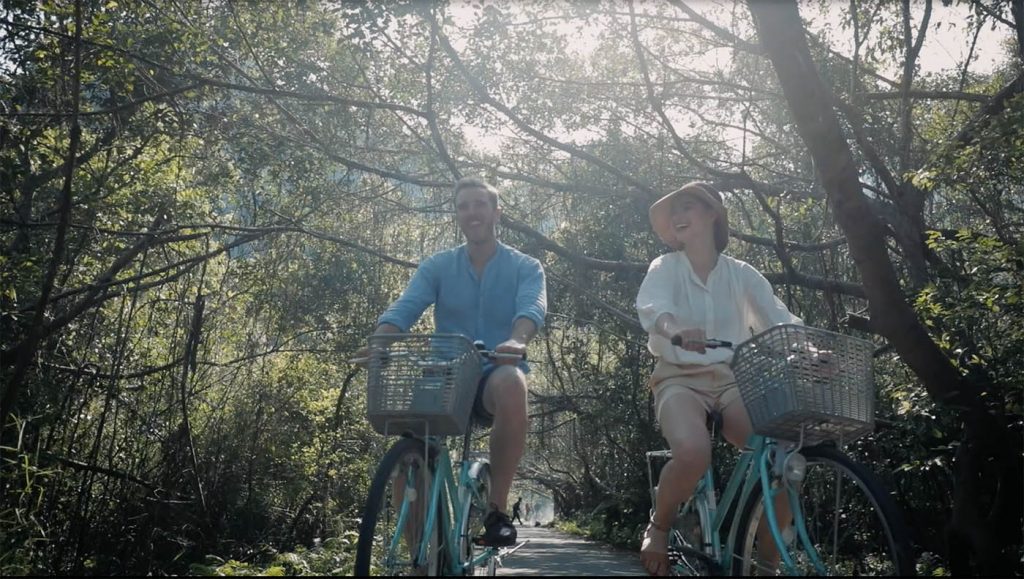
Viet Hai Village
Overview
Viet Hai Village is a small village, located in the core of Cat Ba National Park in Cat Hai Island district, Hai Phong. Due to its remote location, there are not many indigenous peoples living there. However, Viet Hai Village has recently become an attractive destination for domestic and foreign tourists, especially for trekkers and bikers.
How to get to Viet Hai Village Cat Ba
Travellers first have to arrive at Beo Port in Cat Ba Island, from there, you take the ferry or boat to Viet Hai Port. Viet Hai Village is about 5 km from the port, you can walk, rent bicycles, take trams to get to the village. Trams can carry up to 12 passengers per trip and the monolithic road to the village has been concretised for easier transportation.
Local life in harmony with nature
Viet Hai Village has over 70 roofs. Most of which are traditionally made from bamboos, clay, and straw. To build an old-style house, they first mix mud and straw into a dense mixture, then cover the mixture over bamboo sticks, leave the mixture to condense to make hard walls. The roof is covered with thick layers of grass. This mud-walled cottage is a typical image of Vietnamese Northern countryside, that only a few ancient villages still retain this unique type of house.
The tranquil and peaceful life in Viet Hai contrasts with the bustling noisy of other tourist attractions. It is good to have some quiet moments, just to relax and get away in a remote area lying in the middle of deep valleys, geographically divided by the ocean that only a few people have ever set foot on.
Community-based tourism in Viet Hai Village
Viet Hai Village has been developing as a community-based ecotourism destination that attracts many travellers. Especially foreign tourists who want to experience and explore rustic village life and wide nature. Community-based tourism is a focus to support the livelihoods of local people, helps them to earn more income, integrates them into the outside world. Despite the lack of conditions, Viet Hai also has many advantages in terms of natural landscape and distinctive cultural characteristics to attract tourists.
Activities in Viet Hai Village for Travellers
Viet Hai villagers are very sensitive when providing services. They send people to tourist centers such as Hanoi, Ho Chi Minh City to learn about community-based tourism and how to apply to their condition. Besides their work on the field, they also work as local tour guides, hosts, and drivers for tourists. Local people supply and directly serve every need of visitors. Some families operate homestay services and set up small eateries providing local specialties. In Viet Hai Village, travellers can admire the simple rustic beauty when walking through the green rice fields, cycling along winding countryside roads, breathing fresh air and feeling the serenity in every corner of this peaceful village. It is such a memorable experience to enjoy the scenery of mountains, forests, and ocean, all in one place.
Years recently, Viet Hai Village has welcomed thousands of visitors to visit and experience the life and activities of villagers. With the extensive participation of locals in organising activities and supplying services, tourism in Viet Hai becomes a unique, attractive and sustainable tourism product.
Lan Ha Bay
Overview
Lan Ha Bay is located in the southeast of Cat Ba Town, adjacent to Halong Bay. This is a peaceful gulf-shaped bay with about 400 islets and islands in various sizes creating a magnificent picture depicting the fairylike seascape. All the big and small islands in Lan Ha Bay are covered with green trees and rich organism, which triggers the curious mind of worldwide travelers.
About Lan Ha Bay
Lan Ha Bay possesses a high density of limestone mountains which are primitive, peaceful and precious in biological value. There are a lot of pristine mountains with many shapes depending on visitors’ imagination such as Wooden Shoe Islet, Bat Islet… Lan Ha Bay is also the cradle of gulfs and caves, which have not been discovered yet. Besides, travelers are stunned by stalactite grottoes with distinguishing features such as Ham Rong Cave, Do Cung Cave, Ca Cave…
Compared to Halong Bay, Lan Ha Bay is more charmingly romantic with 139 golden-sand beaches, lovely and desolate beaches inviting visitors to explore. Many sandy beaches stretch between rocky mountains offering quietness with no big waves, which are really the ideal places for swimmers. And under the turquoise water in Van Boi Beach, Van Ha Beach, Sen Island, Monkey Island, travelers can also get snorkel and dive to appreciate the colorful coral reefs and many aquatic creatures.
Da Chong Islet
Ho Ba Ham Islet
Overview
Ho Ba Ham Islet lies on Dau Be Island in the southernmost part of Halong Bay, 25 km away from the tourist port. Ho Ba Ham Islet is in the middle of a narrow rectangular sea, surrounded by high upright limestone mountains. Under the foot of the mountains, there are three water caves. To go from one cave to another, visitors have to sail through tunnels with low domes. From the ceilings, many stalactites hang down creating beautiful natural scenery.
About Ho Ba Ham Islet
Natural characteristics of Ho Ba Ham Islet
Ho Ba Ham Islet consists of three large lakes interconnected by a narrow winding tunnel. This tunnel is actually the upper part of a water cave, a typical form of limestone karst that was eroded by water, waves, and tides. Each cluster of colorful stalactites drops from the tunnel ceiling with strange shapes. On the islet, lots of evergreen plants like orchids, banyan trees, palms are growing to create a favorable living environment for endemic animal species of Halong Bay such as golden monkeys, flying squirrels, bats, rare birds. Under the blue water of three lakes, there is the vibrant life of many marine species.
From the entrance, visitors will go through a tunnel into the first lake. Inside the tunnel, stalactites in multi colors look like a bunch of fibrous roots. Going about 100 meters further, there is a light beam from the ceiling of the tunnel, where you will see many kinds of orchids clinging to the cliffs, clusters of evergreen trees in rocky mountains. Then, the second lake opens and has an ancient star fruit tree growing on the southeast cliff that gives fruit all year round. Passing through a cavern for about 5 minutes from there, you will reach the third lake. This is a peaceful home to many kinds of rare birds and butterflies.
The ecological diversity of Ho Ba Ham Islet
Ho Ba Ham Islet still retain the wild and mysterious nature without the impact of human. With ideal ecological conditions, Ba Ham Lake is a habitat of typical ecosystem. There are many endemic plant species of tropical forests growing on the cliffs such as azaleas, ferns, and palm trees. Squirrels, monkeys, birds also choose this place as their home and often go out to eat, so visitors can watch the animals like in a natural zoo. The water of three lakes is crystal clear to see the fish swimming around and special aquatic systems at the bottom.
Things to do in Ho Ba Ham Islet
With many great advantages, Ho Ba Ham Islet is gradually becoming one of the most attractive destinations in Halong Bay. To explore the beauty of Ho Ba Ham Islet, visitors can row bamboo boats or kayaks to go further into the lakes. It is also an ideal place for swimmers and snorkelers. Most of cruising itineraries are considered Ho Ba Ham Islet as a highlight of the trip. You should choose the overnight cruise to have a good amount of time to visit this interesting destination. It is advisable to rent a kayak to truly enjoy a moment of your own and admire the charming beauty of Ho Ba Ham Islet.
Cat ba Island
Overview
Cat Ba Island is located only 30km from Hai Phong city center and 25km from Ha Long City. From Hai Phong, it is very convenient for tourists to take a ferry or speedboat to visit Cat Ba. Or you can enjoy cruising from harbors in Quang Ninh to have an exciting journey through the Natural Wonder Halong Bay to reach Cat Ba Island.
About Cat Ba Island
Best time to travel to Cat Ba Island
Cat Ba Island has a favorable weather condition, so visitors can travel Cat Ba all year round. In any season at any time, Cat Ba has its unique charm. While domestic tourists often go there in the summer, international tourists mainly visit Cat Ba Island from November to March.
High season in Cat Ba is the summer time from May to August, therefore, if you can arrange, you should go before or after the high season, or you should go in the weekdays to avoid the crowds.
Cat Ba’s natural charm
You will feel like to enter a new world when setting foot on Cat Ba Island. It is very comfortable and refreshing to travel on the road through the dense green forest to reach the island heart. The mountain passes are quite challenging for the adventurous tourists. Admiring the spectacular sceneries on the road, you will understand why biking tour across the island is the first choice of foreign guests.
How to get to Cat Ba Island from Hanoi
- BUS from Hanoi to Cat Ba Island
The fastest and cheap way how to get from Hanoi to Cat Ba Island by bus. Bus is going over the longest sea-crossing bridge in Southeast Asia – Tan Vu – Lach Huyen (opened in September 2017) and is going directly to the Cat Ba town on the island over the Cat Hai Island. A short boat transfer of bus (10 minutes) from the Got Port (Bến phà Gót) to the Cái Viềng port.
Bus is going over the longest sea-crossing bridge in Southeast Asia – Tan Vu – Lach Huyen (opened in September 2017)
- TRAIN + SPEEDBOAT from Hanoi to Cat Ba Island
First let’s cover the details for taking a train and then a speedboat from Hanoi to Cat Ba via Hai Phong. Hanoi Railway Station is pretty central and only around a 20 minute walk from the centre of the old quarter.
From here you will take a train into Ga Hải Phòng Railway Station. This part of this route option from Hanoi to Cat Ba will take around 2 hours 45 minutes.
- Speedboat from Hai Phong (Pha Binh port) to Cat Ba Island
- BUS + SPEEDBOAT from Hanoi to Cat Ba Island
Bus from Hanoi to Hai Phong
This last option for getting from Hanoi to Cat Ba involves first taking a bus from Hanoi to Hai Phong and the speedboat option from Hai Phong to Cat Ba as detailed above in option 2.
- FLIGHT from Hanoi to Tuan Chau Island (Seaplane)
Swimming in Cat Ba Beaches
Things to do in Cat Ba Island
In Cat Ba, there are 3 most popular tourist beaches: Cat Co 1, 2 and 3, with clear water and near the town center. In particular, Cat Co 1 beach is larger and more favorable, with three sides surrounded by rocky mountains. Cat Co 2 and 3 are smaller but quite peaceful. The beaches are connected by a small path along the mountain.
Hiking
If you want to have a panoramic view of Cat Ba, you should hike the crest of 177m high Gun Fortress. It is not only a historical relic, which marked the brilliant achievements of the local people; this place also has an ideal location with 3 sides facing the ocean. What a spectacular location to just sit there while sipping coffee and watching the romantic sunset.
Kayaking
The best water sport to try in Cat Ba is to go kayaking. You are sure to be overwhelmed by the majestic landscape and seascape here.
Cat Ba National Park
Cat Ba National Park is one of the unique biosphere reserves recognized by UNESCO. This is a real paradise for those who love to explore nature and challenge themselves. The typical route is only about 1.8 km, while the longest crossing mountain to Viet Hai fishing village is about 16 km. You can see countless species of endemic species, luckily you can see the Cat Ba langur – the symbol of the island.
Halong Bay
Halong Bay is one of seven wonder in the world, with area is 1553 km2. Halong Bay consists of 1969 island and islet, most of which are limestones. specific feature of Ha Long Bay is the abundance of lakes inside the limestone islands. It was declared twice time by UNESCO in 1994 and 2011. The limestone in this bay has gone through 500 million years of formation in different conditions and environments. The evolution of the karst in this bay has taken 20 million years under the impact of the tropical wet climate. Ha Long Bay is home to 14 endemic floral species and 60 endemic faunal species.
Halong BAY, NATURAL WONDER OF Vietnam
Ha long bay attains world heritage status.
On 14 December 1994, at 17.00 hours, at the famous Le Meridien hotel in the southern city Phuket, Thailand, the World Heritage Committee unanimously decided recognize Ha Long Bay as an area of world heritage value.
The fact was warmly welcomed by the Vietnamese people and by all countries as good news. So , from now on, the list of world heritage includes a natural heritage of Vietnam, further enriching the treasure of mankind’s heritage.
HALONG BAY’ LEGEND
Where and when does the name Ha Long originates from? The following related by the local people:
“In the olden day when the Viet people began to discover their country, foreign aggressors came. The Emperor of Jade sent Mother Dragon and a heard of Children Dragons to help the Viet fight the invaders. While enemy vessels, were launching massive attacks against the mainland, dragons descended in flocks from the sky.
They spited out a considerable amount of pearls. These precious stones changed immediately into jade stone islands. Here they were linked together to form a citadel, there they spread out into a battlefield to check the enemy advance and create favorable for the Viet to gain victory.
After the aggressors were driven out, Mother Dragon and Children Dragons did not return to the Heaven’s Court and remained on earth at the place where the battle had occurred. The spot where Mother Dragon landed was Ha Long and Children Dragon came down was Bai Tu Long. The place where their tails wriggled violently was named Long Vi, I .e the present Tra Co peninsula with its beach spreading over dozens of kilometers of smooth sand”
GEOLOGICAL VALUE
Most of Ha Long islands are limestone islands concentrated in Hong Gai bay and schist islands grouped in Cam Pha Bay . Today the land islands like Tuan Chau, Ngoc Vugn, Quan Lan Reu Thua Cong are inhabited by people and animals as a result of transformation of schist islands.
Ha Long terrain comprises islands, mountain alternated with sea depressions which are salted flat expanses of mangroves, and abrupt limestone islands; this is a quite contradictory relief. The terrain is the most ancient of one of the territory of North Vietnam.
Prior to and in the primeval times, was a part of the immense region of mountain ranges alternating with sea depression like the present island area of south east Asia. This terrain was the result of great undulations such as the Caledonian (300 million years ago) Hersinian (250 million years ago) folds. These undulations also shaped sediments of different categories of stones from the lime.
Stone lying deep in the water (in the carbon age) to quartzite along the seashore. In the same period of these undulations, a layer of organic limestone of thousand meters took shapes: it was origin of the limestone ranges of Bac Son, Dong Van, Sa Phin Sa Chay and thousands of stone islands in Ha Long Bay.
Tanks to the motion of into being with 1.600 islands of various forms.
After the Hersinian fold , the terrain of North Vietnam bore a changing and contradictory character, that is to say stone islands alternated with sea depressions.
175 millions years ago, Indosinad orogery much more powerful than two previous folds turned sea depression into the mainland, creating South east Asian land in general and North Vietnam in particular.
However, there were as which had not influenced by the Indosiniade orogery and still maintained its relief unchanged after the Hersinian fold, i.e. Mountain islands alternated with sea depressions in which there were lime clay sediments and salted sediments, ha Long terrain is just one of these areas.
Others sedimentary deposits were buried along with vegetation belonging to fern species and were turned into present northeast coal mine.
So Ha Long terrain comprises bow like islands mountain alternated with profound sea depressions shaped after the Hercinian fold 250 millions years ago. Though since then the earth’s crust has experienced successive undulations, Ha Long terrain has not fundamentally changed.
Its why tourists visiting Ha Long do not only come to see a wonder created by the earth under sky but also a very valuable geological museum kept in the open air for 250 million years, a museum on the primitive face of the territory of Vietnam.
Grottos at different levels on stone islands of Ha Long Bay are not only palaces of Nature but also testify to the seawater encroachment in different ages. At Bo nau and Trinh Nu grottos entrances, one still finds the encroached water level 4-6 meters higher than the present one.
That is the consequence of Ris and Wur glaciers raising the sea water level: It is called the late Pliocene marine transgression, 30.000-40.000 years ago. Then the last glaciers lowered the sea and ocean water, and the sea retreated from the Bac Bo Gulf. The traces of ancient rivers have still remained at the bottom of Ha Long Bay. They are formed in this area.
18.000 years ago, the last glacier raised the ocean water level called the Flandirian marine transgression, drowning the plain of Ha long Bay into the sea. And returning to the relief of mountain islands alternated with sea depressions. After the marine transgression reached the maximum level about 3.000 years ago, the sea gradually retreated and the present table level has been maintained.
So the transformations of the earth’s crust over 250 million years as from the Hercinian orogeny have left traces at different levels on Ha Long Bay, in which the present relief of the Bay mountain islands alternated with profound sea depression is the most ancient remaining terrain of North Vietnam.
BIOLOGICAL VALUE
The distinguishing features of Ha long lie only in its interesting and charming landscape, not only the fact that it preserves vestiges of changes of the earth’s crust, but also in that it has a rich, rare precious fauna and flora. And it may be considered a zoo, a zoological and botanical garden.
As regards Ha Long ‘s fauna , mention should be made of the riches of shrimp and fish species.
According to initial estimates by the Quang Ninh sea Product Services, Ha Long has 1.000 fish species , of which 730 have been identified . Ha Long fish comprise mostly fo those living near the bottoms of the sea and those close to the surface. Ha long has delicious fish species such as stromatcus, mackerel, tunny-fish.
Among fish species such as herring, gizzard-shad, lizard-shad, lizard-fish long -jawed anchovy etc. Usually caught in hauls fish netted in the bay herring gizzard-shad, lizard fish account for 54% of 3.000-4.000 tons. Ziggard- shads live near islands, when laying eggs they emigrate to estuaries. At Quan lan island, people catch 2 tons of gizzard-shads in one haul. Catching time lasts from October to April of next year.
Ha long is an environment appropriate for most tropical fish. Ha long has a relatively mild climate. The temperature does not change much from one season to another: in the cold season, the average is 16-17 degree C . Salt concentration of Ha long bay is quite high compared with other Vietnamese seawaters, from 23-34,5%. The tide amplitude is large, but the bay has no waves and is calm most of the year. The formation of stone island forests in the bay turns Ha long into a gigantic pond, which suits the living conditions of many fish species. On the other hand ephemera pouring from estuaries into the bay constitutes abundant feed for fish. The above favorable conditions helps fish in Ha Long to have a stable life the whole year.
They don’t need to emigrate like fish of other areas.The special features of Ha long also bring a bout particular distribution of fish species here. In other seawaters, large fish, wild fish live offshore, in the deep sea, which is favorable for them to seek shelter and feed. At ha Long , the seashore is sloppy and the bottom is deep. The forest of islands spreads out shape creating dark blue tones on the water surface. The deep bay is covered by shades and has caves, so large fish a wild fish can live near the shore, hidden amongst the shelter of island forests.
Ha long has many squid species calamary, cuttlefish. When boiled they are sweet and nutritious. The squid species having the highest output and nutritional value is cuttlefish.
Fish, shrimp, squid and crab are reputed sea products of Ha Long and other areas of Vietnam . But Ha Long has some special sea areas don’t have.
Pearl oysters are on eof these special sea products. From ancient times, Ha Long sea was reputed as having many pearl oysters. Among Ha long’ special sea products is Sa Sung, less known to tourists but of high economic and nutritional value.
Ha long has 2 corla species: a branch and a fan species. Branch species are slender like tuberose or dense like a bush wood losing its leaves in winter. Fan species re fan – shaped or curved like a lotus petal, a lid or a dish.
Many other sea products exist plentifully in Ha long waters that other sea areas don’t have such as sea-slug, stockiest formerly only available to be presented to kings, area granosa famous on the Indochina market for a time. On fine days, on market day along side Ha long’s shore, we can see fresh shrimp, fish, crab and snail species displayed everywhere for sale in the market and this illustrates the richness and generosity of Nature in Ha Long.
If Ha Long sea has a lively life in the four seasons, with shrimp and fish species, forests of islands are, day and night , bustling with wild beasts and mountain birds.
Ha Long’s islands are abundant in wild beasts such as the white-headed monkey, antelope, iguana, fox, rabbit, flying squirrel, wild boar spotted deer, monkey barking deer, and mouse- bodied bat.
Ha Long has many bird species in its tropical forests: leaf bird, dove, pleasant, picus, halcyon, black-collared starling and little egret. But what is attractive for people who are fond of birds are parrots that can reproduce the human voice. In the mornings when the sun begins to rise up along the edge of island forests, the twitter of parrots lessens the deserted atmosphere of remoter seawaters. Formally the French liked very much Ha Long ‘s red billed and green-tailed parrots and used to sell them to the owners of birth gardens in Paris.
The vegetation cover of Ha Long’ s islands is quite diversified, including primitive and artificial forests, with precious woods, and flower specious.
NATURAL LANDSCAPE
Ha Long is wonderful artistic work of the Nature: It is a sophisticated coordination of sculpture and painting, of strength, grace and picturequeness. Ha Long is not a static piece of art work but incessantly changes in its appearance is also changed when looked at from different angles, creating unusual sceneries, making visitors fell surprised and embraced.
Ha Long is the only sea in area in Vietnam where, on a not very large surface, stand thousands of islands with a variety strange forms. These mountain islands gather together in two large sea groups, one, is the south and southwest of the Bay and the other in the east? Between these two mountain islands groups, is a fan shaped profound sea depression without any island in between wants to give visitors a comprehensive panoramic view of the wonderful landscape.
If the sea areas of mountain islands were viewed form a plane the surface of the bay would look like an emerald green mirror twinkling with multiform blue gems. Islands in Ha Long Bay are not monotonous and dreary but constitutes lively word with the appearance of mysterious living beings. Almost every island has a familiar shape which makes us think of the living world. This form looks like a fisherman, fog’s head. Others have the appearance of a pair fighting cocks , of a toad, a cat a galloping horse on the water surface etc. It seems all of them have inner feeling full of mystery and idyllic dreams.
When sailing in Ha Long Bay with thousands of big and small stone islands of being in a word creatures that were petrified millions of years ago. Look at the foot of Stone Island close to the water surface. Here the sea has perseveringly carved delicate and strange figures with many strata and layers sewing as ornament similar to that on stone columns of temples.
Some islands have their foot eroded so deeply that it appears to bee fragile to support such as heavy mass of the huge island body, which becomes so grotesquely unproportionate.
The wonderful carving of Nature has turned Ha Long islands into real works of sculpture. And natural relief pictures which constitute a unique, lively architectural ensemble in the shape of a pyramid, a parallelepiped or a cone, standing imposingly in middle of the sea depression like a grandiose symbol of the past. Some islands have the form of enormous cubes, black and smooth as if they were made of well planned iron wood; others are curved the shape of an elephant tusk which has been made sharper and more pointed by the wind as it soars further in to the sky. Others are formed by separate stone blocks piled up one upon another into a pyramid or lined into a row of several peaks bay looking of an unfinished work of sculpture or the ruins of a collapsed ancient palace.
To go sailing in Ha long is perhaps the most peasant way of visiting the bay; one could silently slowly admire different corners of the mysterious clusters of islands.
From Bai Chai, the boat will take us rapidly across the Bay of Hong Gai to the southern and southwestern island area. In the distance, the islands appear to be a solid citadel wall separating the high seas from the waters near the coast and making the horizon line. When the boat comes nearer, the citadels wall suddenly breaks up and a multitude of sea lanes open to our eyes winding and passing through the citadel wall. The boat glides on the dark blue water in the shades of steep faced mountain. Sometime when we go sailing, a line of island suddenly stands in front of us baring the lands, we thought that we are driven to an impasse. But when our boat reaches the islands, they seem to make room for us to pass by and open unexpected ways leading us to a forest of others islands which are both familiar and alien.
A great number of tourists are surprised at and feel a passion for the scenery of Ha Long bay now appearing, now disappearing, with so quick changes in a moment
In spring when the vegetation cover around Ha Long begins to produce blooms and buds, the Bay becomes a mysterious world of nature.
Early in spring in Ha Long, island flicker on the vast silvery screen of mist, in which dark blue mountain tops bob now appear, now disappear. The coarse, strong, rugged stone mountain become suddenly soft and flexible as if they were painted with a quill. When the sun rises high in the sky fog in the surface of the bay gradually melt away, only left a thin membrane moving on the islands. The later look like gray haired fairies sitting meditatively on the bluish green surface ion the bay, reflecting in the bottom of the bay , making an impression that stone islands have roots.
Summer in Ha Long is the season of southeast wind. The endless wind blowing from the ocean across ranges of mountain islands brings the mainland the freshness of high seas. In summer, if one stays in Bai Chai tourist resort on will make the most of the very fresh wind blows unceasingly from the sea. Tourist of all corners flock into Ha Long, take a rest in Bai Chay or Tra Co Peninsula to benefit from wind and take a sea bath. After one night of struggle with the high seas, fishing boats make their ways through the southern forest of islands and gather on the wharves. They’re white, brown, red sails fully as a gigantesque bouquet of fragrant flowers of the sea. Sunrise on Ha Long Bay is really a wonderful view. All tourists who come to Ha long for the first time earnestly wish to see with their own eyes this memorable moment in Ha Long.
In summer in Ha Long Bay, the sun shines over the water surface rippled with silvery gentle waves. Stone mountain lines up showing their bare ruffed breast. Here and there, tuffs of orchids grow on cliffs; their yellow, white, violet soft blossoms emit sweet fragrance in the healthy atmosphere of the sea.
In the evening, when stone islands turn from blue to dark violet, there remains only the blazing red coal globe which gradually moves to the west, then disappears behind the row of islands, casting golden glows on the skyline. That is the moment when Bai Chay beach has a bustling life.
Summer in Ha Long is a season of tourism and swimming. On land road and waterway, tourist flock into Ha Long with an earnest desire to admire a natural wonder. Along the one kilometer windy and sunny beach of Bai Chay, tourists in their swimming costume take either sea bath or sunbathe with such animation as a festival. On Ha Long wharves, airy and stand ready to bring tourists to the mysterious word.
In mid summer when the oceanic wind suddenly stops blowing and the hot, a coming shower or a typhoon originating from the Pacific Ocean. In ha long, showers usually drop at noon or a short moment after noon; black clouds suddenly cover the clear blue sky, then come thunder in successive peals and repeated lightning. Strong wind begins to blow. In some violent storm, columns of water rise up suddenly from the surface of the bay fire horse. And Ha long has its typical beauty in a storm.
In a moon of autumn, sitting on Ha Long shore, we will find that Ha long is dashingly beautiful and mysterious. The quite surface of the bay looks likes a mirror reflecting the silvery moonlight gleamy like mercury. At moonrise or at moonset, the islands appear in half lighted, half dark scenery, only the wind blow and sea breaths are heard. Islands, which are so familiar in day time, become alien and mysterious at night.
Ha Long aesthetic value does not only lie in the shape of mountains, colors of the sky but is also hidden in grottoes. The most beautiful cave of Ha long Bay, in my opinion, is Thien Cung grottoes. (Heaven Cave)
In 1994, the guardians of Dau Go grotto explored the surrounding and they discovered a new cave that so far no one has set foot on. This is a Thien Cung grotto, also called Bach Tuyet grottoes. It lies in the same island as the Dau Go grotto, about 150-m away from the later. Its opening is small and looks on the North, on the almost perpendicular wall of the island, about 80-m above water. The opening of Thien Cung is about 25m above that of Dau Go. It was previously unheeded because its opening was small and high and covered by climbing wild plants.
Thien Cung is the largest and highest situated among the caves in Ha Long Bay.To visit the grotto, we must climb the steep slope, crawl under the climbing liana, amidst the good smell of orchids and the singing of birds. Visitors will have the pleasure of mountain climbing and the enthusiasm of being on the way to Heaven.
The Thien Cung has a rectangular section, about 25m wide, 250m long, and 20m high, lying in the North South direction. From its opening looking inside, we have the impression that it is very spacious and abroad. The further we go inside the more surprised and deeply impressed we are by the Wonder of Nature. On the opposite Eastern and Western walls are too giant magnificent bas-reliefs representing men and animals and also strange shapes that we have never imagined…The lines of the sculptures, rough or smooth to touch, the stone cutting is clear and neat, Here are representation of a kneeling elephant, a cuirass horse with brilliant swords and shields. Looking to the ceiling in the east we are amazed by the living fugues of the Heaven Court: The Emperor of Jade, the thunder God, the Nam Tao and the Bac Dau god with their beards and hairs floating like clouds.
There are fine looking fairies with their gorgeous clothes, absorbed in their dancing and singing. Hanged in the middle of the air is the marvelous stick of Monkey King who made disturbances to the Heavenly Court. Now and then, the stick emits light, it 2 meter long a circular section perfectly straight as if some one has leaned it on a stalactite at one end and at the middle of the grotto ceiling and on the eastern weal at the other.
Each wall of the grotto is a wonder; each compartment
of the grotto is a sculptural masterpiece. Under the high and broad vault, the light blues of the stalactites and stalagmites make them look like being silver-plated . Standing among this world of strange shapes, both real and unreal, we believe having been lost in the mysterious and overwhelming Heavenly Place.
Sung Sot grotto lies in the Ho Hon Island the same row of islands with Trinh Nu grotto. To visit this grotto, one should walk under a large parasol of vegetation, on lottery stone stairs. The grotto has two compartments: The outside one of 30m high looks like a perfectly square waiting hall. The smooth vertical partitions are similar large man walls. The skilful hands of Nature have covered the compartment with a modest violet blue paint with here and there some rosy veins.
From the outside to the inside compartment, one has to go through a 3 meters long passage, so narrow that there is barely enough rooms for one person. This inside compartment is a quiet building decorated with lively stones statues. What is brought in relief is at the entrance a group of another as if they were discussing confidential army affaires. Lying at the feet of “army generals” are petrified crocodiles, lion’s cubs and squirrels. Awhile imposing stalagmite and stands in the middle of the floor of the grotto’ if looked at more carefully, it has the shape of an army officer clothed in an overcoat, standing akimbo with face up looking ahead.
The visitor goes form surprise to surprise so this grotto has this name ‘Surprise grotto’.
HA LONG CULTURE
Ha Long is not only the concrete image of thousands of large and small islands in limpid and blue seawater. Today, according to archaeological research, Ha Long is till symbol of an ancient culture: Ha Long culture
VAN DON THE MOST ANCIENT FOREIGN TRADE SEA PORT OF VIETNAM
Van Don, now belonging to Van Hai archipelago, lying in the south east of Ha Long Bay, located on Bai Tu longBay, was considered by Nguyen Trai a wonder of country which has very beautifully depicted in his writings.
The complete History of Dai Viet writes “In the Ky Ty year, the 10th year of Ly Anh Tong reign(1149) in spring the second lunar month, Javanese and Siames merchant ships entered the East Sea for trade. They were concentrated in island area, called Van Don, for trading precious goods, and presenting local products”
QUAN LAN: ISLAND OF RUINS HAD PLENTY TO OFFER
These days sleepy Van Don Island may seem like it is being left behind by a rapidly-changing world.
However, the locals will be only too happy to tell you of a time when the island occupied centre stage in the nation’s history.
For this unassuming community on the perimeter of picturesque Ha Long Bay in Quang Ninh Province has a glorious heritage. It was the country’s first international commercial sea port in the 12th century and the site of the first successful naval battle against foreign invasion in the early 13th century.
Now, it is hoped that the island’s dramatic past, coupled with its unspoiled natural beauty, will make the island a place of action again, this time as a prominent eco-tourism destination.
A joint venture has ambitious plans to offer a tour of Van Don’s pristine wilderness, where tourists can stay in stilt houses, swim, scuba-dive, and trek through the forest to see the ruins of the old port.
Food abundant out there
If you ask the islanders whether they have any plans to increase their meagre incomes, they will look somewhat confused. There is plenty of food on the island, they reply – it’s there for the taking in the wild.But apart from the abundant food supply, the island’s residents seem blissfully unaware that they are living on a veritable gold mine. The island is rich in a number of resources that are only just starting to be developed.
The vast stretches of white sand dunes along Van Don’s coastline are one example. The sand is now being used for crystal and glass-making industries.
Just below the sand lies another source of wealth: sea worms. These dried worms fetch up to VND500,000 per kilo on the nearby Chinese market. Hunters require just a shovel and bucket in order to rake in a comfortable living.
With an area of only 60sq.km, space to farm on the island is scarce. Locals have adapted to the conditions as best they can, and the island is now a patchwork of terraced lots slotted in amongst limestone mountains and beaches. Here, residents grow wet rice, vegetables and cash crops such as ground nuts, tea, and sweet potatoes.
However, it is the sea that truly provides the key to the heart and sou

